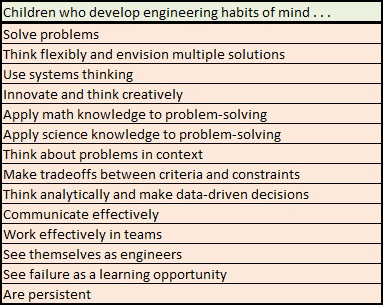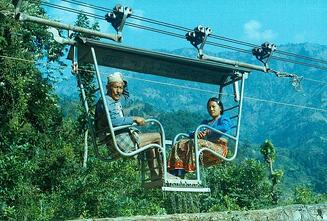For the next several weeks, the EiE Blog will explore a set of skills called “engineering habits of mind.” This phrase comes from a landmark report released by the National Academy of Engineering (NAE) in 2009 that laid out guiding principles for how engineering should be taught in grades K through 12.
The six “habits of mind” NAE identified are
- systems thinking
- creativity
- optimism
- collaboration
- communication, and
- ethical considerations.
These habits map closely to the set of skills many educators consider essential for all students who will grow up to be citizens of this modern world.

Here at EiE, we’ve had the opportunity to make extensive observations of elementary school-aged children engaged in hands-on classroom engineering. We conclude that well-designed engineering education does promote the six engineering habits of mind specified by the NAE . . . and more. (See the table at the right.)
Watch it happen: Kids make data-driven decisions

Watch the short video above to see third grade students demonstrating several of the habits on our list, in particular, “making data-driven decisions,” but also “working effectively in teams" and “communicating effectively.” The students have been working on the EiE geotechnical engineering unit called “A Stick in the Mud: Evaluating a Landscape.” Their engineering design challenge is to identify an appropriate site for a gondola-like bridge called a TarPu (pictured at right).
photo credit: Village Tech Solutions
A few days earlier, these students read an EiE storybook about a boy in Nepal who helps engineers choose an appropriate site for a TarPul that villagers can use to cross a fast-flowing river and reach a medical clinic. Now the students are tackling the same challenge they’ve read about—choosing a site for a bridge (theirs is a model made with string, sticks, and a Dixie cup).
They have a map of the river that shows the possible bridge sites, labeled A, B, C, D, E, and F. Their teacher tells them it’s time to decide—as a team—where they will place their bridge.
Arguing from Evidence
The students take turns presenting the pieces of data that support different choices, engaging in a practice that is critical for both scientists and engineers: arguing from evidence. Notice how they apply what they’ve learned from earlier science lessons about the erosion of riverbanks.
They also apply what they’ve learned from the storybook about cultural constraints on the bridge site: the boy’s grandmother (Agee), who has been sick and may need to go to the clinic, can’t walk very far.
Ultimately, these students reach a decision about the best site for their bridge using a strategy that (usually) is not a typical part of the engineering design process! But along the way, they’ve worked as a team, communicating skillfully as they argue from evidence and work toward a data-driven decision--demonstrating that they’ve mastered key engineering habits of mind.
Want to see more classroom engineering? Check out this video to see fifth-graders in Bremerton, Washington work through EiE’s geotechnical engineering design challenge.
Engineering is Elementary is a project of the National Center for Technological Literacy at the Museum of Science, Boston.








